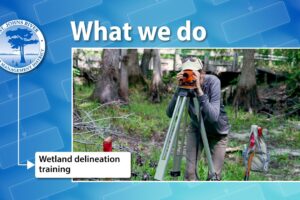Promoting water conservation in Florida: A collaborative approach for a sustainable future
June 22, 2023
District staff recently learned about the latest studies focused on multiple turfgrass species and their water requirements as part of a collaborative workshop on water conservation at the University of Florida.
The University of Florida (UF) Turfgrass Researchers recently brought together a diverse group of professionals who all share the common goal of conserving our state’s vital water resources.
The event featured representatives from various organizations such as the Florida Department of Environmental Protection, St. Johns River Water Management District, Suwanee River Water Management District, Southwest Florida Water Management District, and county and water utility conservation staff, and representatives from irrigation and soil amendments companies. This group fostered a fruitful exchange of knowledge and ideas, setting the stage for a collaborative effort to address the pressing challenge of water usage in turfgrass maintenance.
The highlight of the event was the unveiling of the latest findings in UF’s turfgrass research. Attendees learned about the ongoing studies focused on multiple turfgrass species and their water requirements to achieve optimum health and vitality while maximizing efficiency.
“The research revealed that turfgrass can thrive with significantly less water than previously believed or currently being used,” said Deirdre Irwin, the St. Johns District’s water conservation coordinator. “This not only highlights the potential for water conservation, but also provides landscape professionals and homeowners with practical insights to achieve sustainable turf maintenance practices. By reducing irrigation application amounts and frequency of watering, individuals can contribute to reducing water consumption without compromising the aesthetic appeal of their lawns.”
In addition to the groundbreaking turfgrass research, attendees were provided information about UF’s investigations into alternative landscaping options that promote low water usage. Native groundcovers and blended species lawns emerged as promising alternatives that can significantly reduce water requirements for landscaping projects. These alternatives offer a glimpse into a future where sustainable and visually appealing landscapes can coexist. This work will also satisfy homeowners who naturally have mixed species lawns. Essentially, a lawn does not have to comprise turfgrass species exclusively.
The event concluded with a consensus among participants to foster collaboration, recognizing that a joint effort is essential to tackle the challenges associated with water usage on turfgrass. By working together and disseminating a unified message, stakeholders can promote water-responsible practices and shape a sustainable future for Florida’s landscaping industry.






